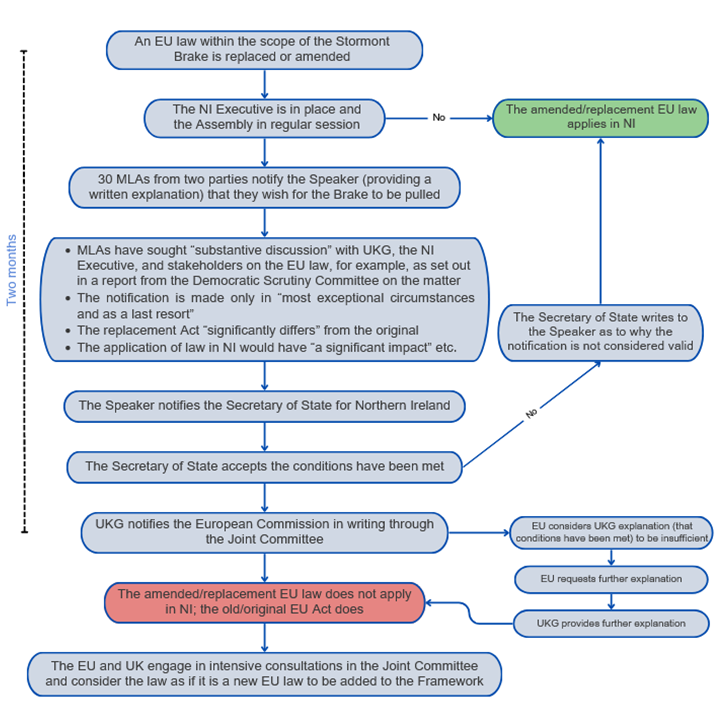The Stormont Brake
This information was put together by the Assembly's EU Affairs Team.
The Stormont Brake may apply to an EU act, which amends or replaces an act which already applies in Northern Ireland under the Windsor Framework. Applicability motions apply when the EU adopts a new act, which it considers to be within the scope of the Windsor Framework.
The Windsor Framework (Democratic Scrutiny) Regulations 2024 inserted a new Schedule 6B (EU Withdrawal: Windsor Framework democratic scrutiny) into the Northern Ireland Act 1998. The Schedule includes provision for a “procedure by which members of the Assembly may seek to prevent the application of a replacement EU act”, known as the ‘Stormont Brake’. Under the procedure, 30 MLAs from at least two parties in the Northern Ireland Assembly can notify the Government of their wish that the “emergency brake” on EU law be pulled i.e. that they wish to stop the application of amended or replacement EU law in Northern Ireland.
There are conditions for the use of the Stormont Brake:
- The Northern Ireland Executive must be operational and the NI Assembly in regular session
- The MLAs who wish to pull the Brake must explain:
- how the notification is being made in “the most exceptional circumstances and as a last resort, having used every other available mechanism”
- how the content or scope of the amended or replaced EU law “significantly differs” from the original law; and its application “would have a significant impact specific to everyday life of communities in Northern Ireland in a way that is liable to persist”
- that they have “sought prior substantive discussion with the UK Government and within the Northern Ireland Executive to examine all possibilities in relation to the Union act; taken steps to consult businesses, other traders and civic society affected by the relevant Union act; and made all reasonable use of applicable consultation processes provided by the European Union for new Union acts relevant to Northern Ireland”
The process
In notifying the Government, MLAs must provide a “detailed and publicly available written explanation” to demonstrate they have met the above conditions. The notification must be provided to the Speaker of the Assembly no later than ten working days before the end of the scrutiny period (of two months following the publication of the relevant EU law in the EU’s Official Journal).
Then, if the Government is satisfied that the above conditions have been met, it will notify the EU in the Joint Committee. This notification must be made within two months following the publication of the EU law and include a “detailed explanation” of the UK’s assessment regarding the conditions set out above. If the EU thinks the UK’s explanation is “insufficient”, it can request further information from the Government.
The EU law will not apply in Northern Ireland in its new form two weeks later (or three days after the UK has provided further explanation). The older (unamended) version of the EU law will still apply.
At this stage, the relevant law is discussed in the EU-UK Joint Committee under the process for new EU laws, Article 13(4). The Government must not agree to add the law to the Windsor Framework (so that it applies in Northern Ireland), unless the Assembly has indicated its cross-community support for the application of that EU act by passing an ‘applicability motion’. If no applicability motion has been passed, the Government may agree to the law applying in Northern Ireland if there are “exceptional circumstances” or the law “would not create a new regulatory border between Great Britain and Northern Ireland.”
The Stormont Brake process

If you experience any issues with the flowchart, you can read this text version.
At the final stage, the process moves to that set out in Article 13(4). More information and a flowchart can be found in the paper on applicability motions.
Background
Under the Windsor Framework (and previously the Protocol on Ireland/Northern Ireland), Northern Ireland remains aligned to EU law relating to the single market for goods. The Framework includes a list of over 300 pieces of EU legislation which apply in Northern Ireland. When the EU laws in that list are amended or replaced, the changes will automatically apply in Northern Ireland, unless the Stormont Brake is applied. There is a different process for new EU law to be added to the Framework.
Areas of EU law which apply in Northern Ireland include legislation on goods, animal and plant health rules, rules on agricultural production, VAT and excise on goods, and state aid rules. The EU’s Customs Code also applies to goods entering Northern Ireland.
The Stormont Brake could be applied to most, but not all, areas of EU law which apply to Northern Ireland.
Legal texts and operational details
- A decision of the Withdrawal Agreement Joint Committee [external link] makes provision for the Stormont Brake by inserting a new Article 13(3a) in the Windsor Framework. The decision includes a unilateral declaration by the Government setting out the procedure and conditions for using the Brake.
- The Government made the Windsor Framework (Democratic Scrutiny) Regulations 2024 [external link], which contains additional details about the Stormont Brake procedures and applicability motions, and establishes the Windsor Framework Democratic Scrutiny Committee.
- The Government published a letter to the Speaker [external link] with additional details about information on EU acts to be provided to the Assembly, and the operation of the Stormont Brake.
- The Government made the Windsor Framework (Constitutional Status of Northern Ireland) Regulations 2024 [external link], which amend section 7A of the European Union (Withdrawal) Act 2018 to reflect the Stormont Brake. Section 7A provides the mechanism for certain EU laws to be given legal effect in the UK.



